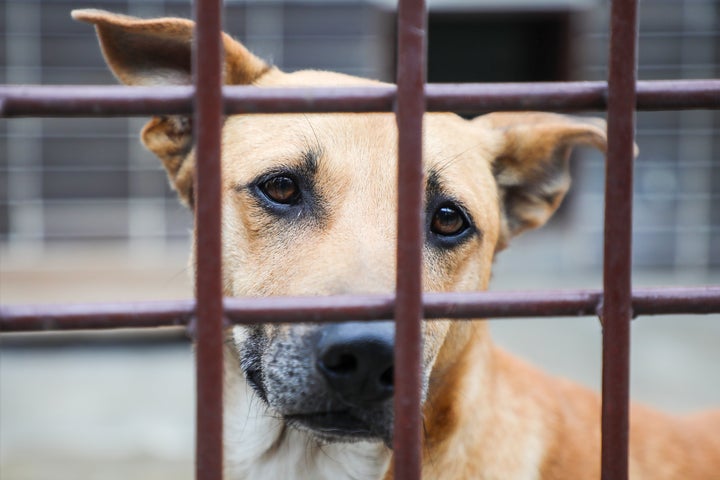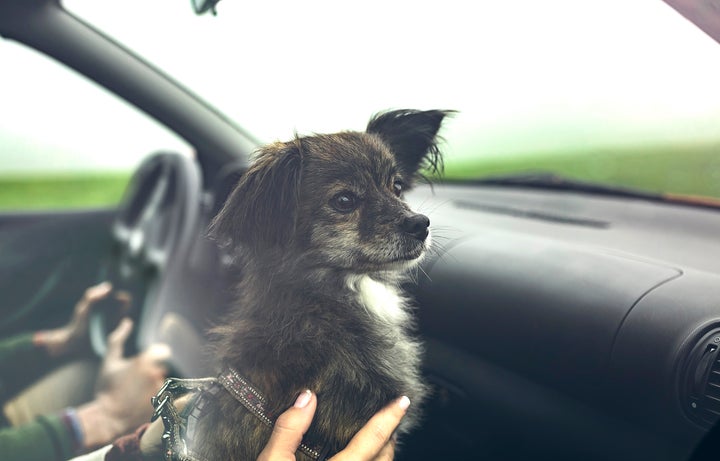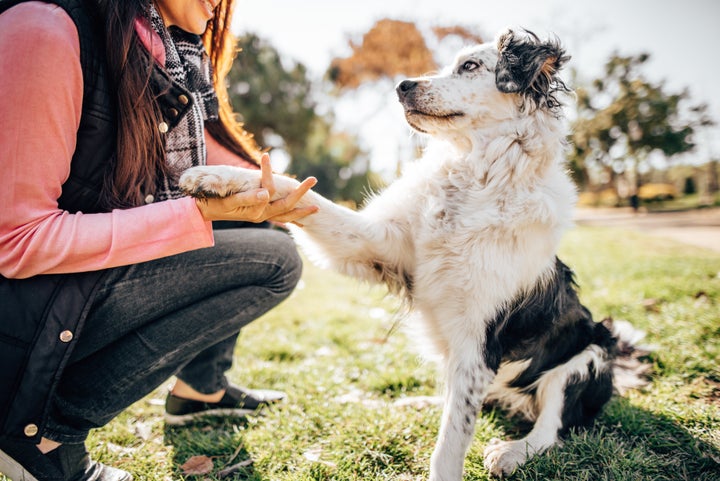It was one of the few genuinely positive stories to come out of the Covid-19 crisis: At the height of the pandemic, with so many of us working from home, animal shelters across the nation reported that they didn’t have enough dogs to meet the demand.
Now as people return to the office and pre-pandemic life, some of those dogs are being left behind. Aron Jones, executive director of Moms and Mutts Colorado Rescue (MAMCO), told HuffPost her group has seen “an unprecedented number of returns” recently.
“The majority of adopters use the ‘I no longer have time’ excuse while others claim they can no longer ‘handle’ their dog,” Jones said.
Early on in the pandemic, Jones said her group changed its adoption application to include questions directly related to the quarantine situation: “How will you transition your dog to being alone once you return to work?” for instance, or “How will you accommodate your dog’s training and exercise needs during and after quarantine?”
Even so, some dog adopters have struggled to navigate that transition with their pets. Since the last week in February, MAMCO has had 62 dogs returned to its rescue. Of these dogs, 39 had been adopted between March and July of 2020.
In a typical 12-month period, Jones said, the group has an average of 50 returns overall. Roughly half of those are dogs or puppies that were adopted up to four weeks earlier ― not a year later, as the group is seeing now among pandemic adopters.

What worries Jones is when the dogs end up at the shelter rather than back at the rescue group.
“Most adopters follow the contract and return the dogs to us, but on occasion we will get a call from a shelter because one of our dogs has been surrendered,” Jones said. “This is terrifying, since shelters can euthanise any dog due to behavioural issues, and many dogs show fear aggression when entering the shelter.”
That said, a shelter is clearly a much better option than abandoning a dog or selling a pet online to a stranger.
Since the pandemic began, the rescue group The Las Vegas Trapping Girls has seen an uptick in dogs dumped around the city or in the desert. In November, the group told KVVU-TV in Las Vegas that it has also seen more “free” dog listings online, which can be dangerous for a pet because it’s impossible to know who will end up with the dog. (In the worst-case scenario, a dog offered up for free could be used for dogfights or as a bait dog.)
Pet shelters and rescue groups want people to come to them first.
“We would much rather pet owners do the responsible thing of contacting a rescue centre than putting a pet’s welfare at risk by selling it online or abandoning it somewhere,” said Rob Young, the head of centre operations at Battersea Dogs & Cats Home in London. “We aren’t ever here to judge people for the reasons behind giving up their pet.”
“Just as if our world got turned upside down we would be confused, so too are dogs, except they don’t understand why this is happening.”
- Nicole Ellis, a dog trainer and pet lifestyle expert at Rover
Of course, even returning a pet to a rescue centre or no-kill shelter can be traumatic, said Nicole Ellis, a dog trainer and pet lifestyle expert at Rover, a dog-sitting and dog-walking app.
“Most of the time, adopted pets have built up their trust and love in you and their new routine,” she told HuffPost. “To be taken away and put into a noisy shelter, filled with smells and sights they’re unfamiliar with, is a tough transition.”
As a result, some dogs become fearful and erratic when introduced to any new situation, according to Ellis. The dogs may take longer to bond with a new owner, or they may pick up new behaviours to signal their distress: barking, pacing and self-harming behaviour, such as excessive licking.
“Just as if our world got turned upside down we would be confused, so too are dogs, except they don’t understand why this is happening,” Ellis said. “They believe they are part of the family, and no family member should go through that.”
Though many shelters have reported seeing an uptick in pet surrenders in recent weeks, national shelter data has yet to show a statistically significant number of returns, according to data from the animal welfare group Best Friends Animal Society.
Best Friends Animal Society hopes to convince uncertain pet owners that they have other options: Dogs can absolutely adjust to their owner’s return to the office. With the right training and preparation, it really doesn’t need to be a huge ordeal, said Holly Sizemore, the chief mission officer for the group.
“By now, many people have undoubtedly discovered the secret reality of what dogs and cats really do all day. Whether there are people around or not, they mostly sleep, with a bit of eating and playing mixed in ― all things that they can do just as easily without human companionship,” Sizemore said.
Below, pet experts like Sizemore offer realistic advice on how to continue to care for your pup ― and how to handle rehoming them if that really is the best option for both of you.
Recognise that the pandemic has had a stressful effect on all pets, not just yours.
Dogs, just like humans, are enduring a really stressful time right now. If your dog is exhibiting behavioural problems, know that that’s very common.
As the COVID-19 restrictions begin to lift around the country, Jones said, her group is seeing a ton of what she calls “pandemic puppies.”
“These are dogs who were raised in quarantine situations by people who were not able to take the dogs to training, dog parks or to socialise with other people,” she said.
Jones likens the dogs to teenagers who lack social skills.
“Many were paired with people who also were not able to be trained in dog behaviour because of social distancing,” she said. “Dog training is actually more for people than it is for dogs, so now both dog and owner are overwhelmed.”

Look into a good trainer.
Jones tells stressed-out new pet owners to take a deep breathe and realise there’s outside help available. Pet owners just need to be willing to take a new approach with a trainer. “Contact the rescue or shelter you adopted from and ask for trainer recommendations,” she said.
“If your puppy/dog is fully vaccinated (the other kind!) start going to off-leash dog parks and socialise your dog,” Jones said. “Go to a park that has an extremely large, grassy area and costs a fee to enter, since that usually deters people who have aggressive dogs.”
Anticipate that your dog may have some separation anxiety.
Erin Katribe, medical director of Best Friends Animal Society, suggests pet owners know the signs of separation anxiety and prepare for it before work schedules change.
Separation anxiety is common among pets that are overly attached or dependent upon their owner. After more than a year of lockdown, that probably describes most dogs right now.
When pets with separation anxiety are left by their owners, they experience high levels of distress and anxiety, which often manifests in some telltale behaviour: barking or whining when you leave, scratching or chewing on furniture, over-grooming or a change in appetite.
“Most pets don’t like sudden and abrupt changes,” Katribe said. “Instead, try starting now to get your pet ready and ease them back to your previously ‘normal’ routine more easily.”
To get dogs prepared for more alone time, the vet suggested a few things:
Create a safe, comfy place where they can have peaceful, relaxing alone time. Maybe it’s a quiet room off to the side in your home or a crate filled up with some Kongs and other toys to keep them busy. (You also might want to buy or make some hidden treats in boxes and food puzzles for mental stimulation)
While you’re gone, play soothing music or podcasts (think reggae, smooth jazz, classical or radio stations like the BBC or NPR). This will keep them from being startled by outside noises. You can also try a white noise machine.
Reward your pup for calm, independent behaviour, especially if they’re usually clingy. Usually, pet owners pay the most attention to their dogs when they’re active or even misbehaving. What you want to reward is calm and chill behaviour.
Practice leaving for short periods of time to run errands or go for a walk. To reinforce the idea that you’ll always come back, tell them you’ll be back later while leaving and announce that you’re back when you get home.

Make sure your dog is getting a good walk and playtime before you leave for work or when you come home.
Providing a pet with exercise, stimulation and a potty break throughout the day can work wonders, Ellis said.
“When you get home, consider some one-on-one time to do a little training together,” she said. “Ten to 15 minutes can go a long way in fixing or preventing behavioural issues, and you’ll find that it will really strengthen the human-animal bond.”
For a dog with a lot of energy, consider day care or midday walks from dog walking platforms, such as Wag or Rover, if you can swing it.

If it’s not possible to keep your pet, make sure you return it to a safe rescue or shelter centre.
Even if there have been some hiccups between the two of you, your pet has no doubt provided you with companionship and comfort through this difficult year. Try to honour the commitment you made at adoption, Sizemore said.
That said, it might still be the case that finding a new home for a pet may be the best option for your and/or the pet if you’ve exhausted other options and your pet’s quality of life is at stake.
“In those cases, we’d encourage you to reach out to your network of friends and family as well as to your local shelter or animal welfare organisation for advice on resources available to re-home your pet,” Sizemore said.
Keep in mind that some shelters are still faced with having to euthanize incoming pets simply because they don’t have the resources to guarantee a positive outcome.
“That means that anything you can do to relieve that potential burden from your local shelter and ensure your pet isn’t put at risk is absolutely imperative,” she said.
Regardless of your dog-owning status, use Best Friends Animal Society’s Pet Lifesaving Dashboard to find out if a shelter near you needs help in saving the animals in their care. If your local shelter experiences an influx of “pandemic pet” returns, your donation could make a big difference.